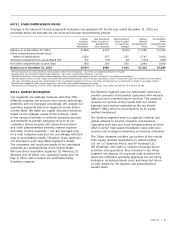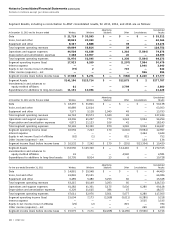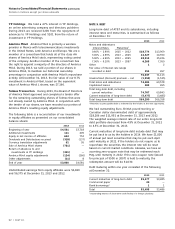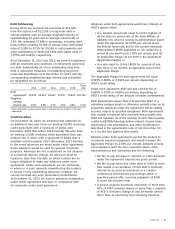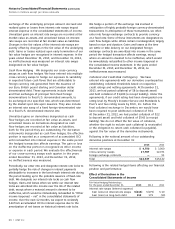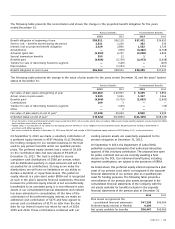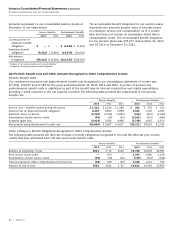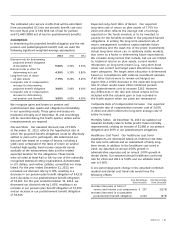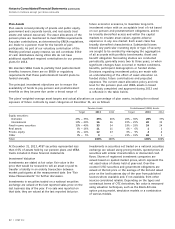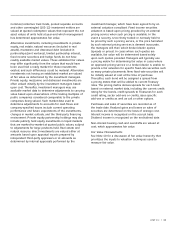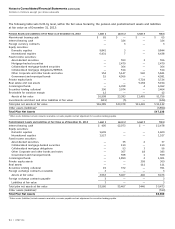AT&T Wireless 2013 Annual Report Download - page 57
Download and view the complete annual report
Please find page 57 of the 2013 AT&T Wireless annual report below. You can navigate through the pages in the report by either clicking on the pages listed below, or by using the keyword search tool below to find specific information within the annual report.
AT&T Inc. | 55
are recorded in accumulated OCI. Unrealized losses that are
considered other than temporary are recorded in “Other
income (expense) – net” with the corresponding reduction
to the carrying basis of the investment. Fixed income
investments of $106 have maturities of less than one
year, $279 within one to three years, $109 within three
to five years, and $265 for five or more years.
Our short-term investments (including money market
securities) and customer deposits are recorded at amortized
cost, and the respective carrying amounts approximate fair
values. Our investment securities are recorded in “Other
Assets” on the consolidated balance sheets.
Investment Securities
Our investment securities include equities, fixed income
bonds and other securities. A substantial portion of the
fair values of our available-for-sale securities was estimated
based on quoted market prices. Investments in securities
not traded on a national securities exchange are valued
using pricing models, quoted prices of securities with
similar characteristics or discounted cash flows. Realized
gains and losses on securities are included in “Other
income (expense) – net” in the consolidated statements of
income using the specific identification method. Unrealized
gains and losses, net of tax, on available-for-sale securities
Following is the fair value leveling for available-for-sale securities and derivatives as of December 31, 2013, and
December 31, 2012:
December 31, 2013
Level 1 Level 2 Level 3 Total
Available-for-Sale Securities
Domestic equities $1,049 $ — $ — $1,049
International equities 563 — — 563
Fixed income bonds — 759 — 759
Asset Derivatives1
Interest rate swaps — 191 — 191
Cross-currency swaps — 1,951 — 1,951
Liability Derivatives1
Interest rate swaps — (7) — (7)
Cross-currency swaps — (519) — (519)
December 31, 2012
Level 1 Level 2 Level 3 Total
Available-for-Sale Securities
Domestic equities $ 873 $ — $ — $ 873
International equities 469 — — 469
Fixed income bonds — 837 — 837
Asset Derivatives1
Interest rate swaps — 287 — 287
Cross-currency swaps — 752 — 752
Foreign exchange contracts — 1 — 1
Liability Derivatives1
Cross-currency swaps — (672) — (672)
1 Derivatives designated as hedging instruments are reflected as “Other Assets,” “Other noncurrent liabilities” and, for a portion of interest rate swaps, “Other current assets”
in our consolidated balance sheets.
The majority of our derivatives are designated either as a
hedge of the fair value of a recognized asset or liability or
of an unrecognized firm commitment (fair value hedge), or
as a hedge of a forecasted transaction or of the variability
of cash flows to be received or paid related to a recognized
asset or liability (cash flow hedge).
Fair Value Hedging We designate our fixed-to-floating
interest rate swaps as fair value hedges. The purpose of
these swaps is to manage interest rate risk by managing
our mix of fixed-rate and floating-rate debt. These swaps
involve the receipt of fixed-rate amounts for floating
interest rate payments over the life of the swaps without
Derivative Financial Instruments
We employ derivatives to manage certain market risks,
primarily interest rate risk and foreign currency exchange
risk. This includes the use of interest rate swaps, interest
rate locks, foreign exchange forward contracts and
combined interest rate foreign exchange contracts (cross-
currency swaps). We do not use derivatives for trading
or speculative purposes. We record derivatives on our
consolidated balance sheets at fair value that is derived
from observable market data, including yield curves and
foreign exchange rates (all of our derivatives are Level 2).
Cash flows associated with derivative instruments are
presented in the same category on the consolidated
statements of cash flows as the item being hedged.




